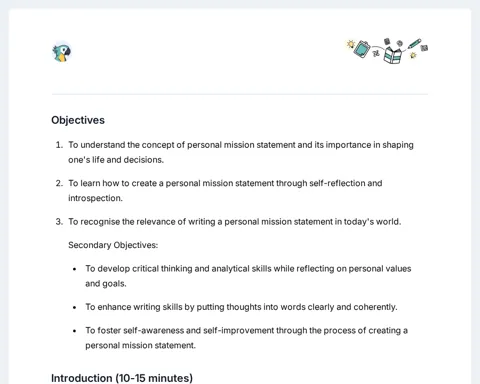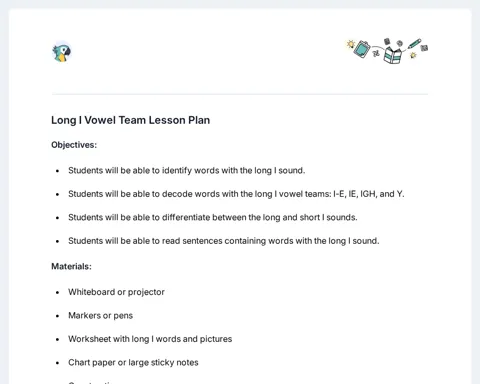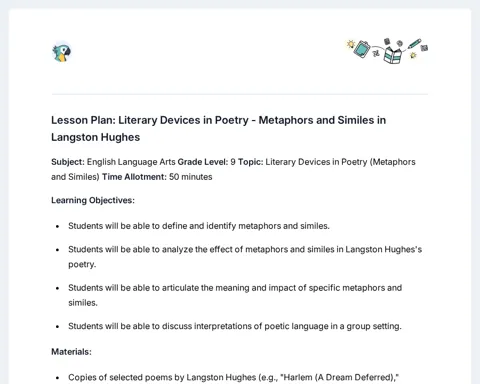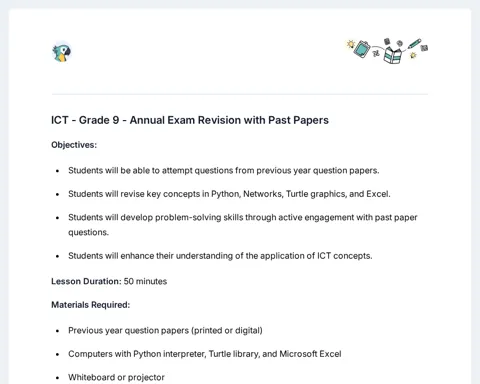Objectives
-
Understanding: Students should be able to understand and identify situations where clarification is needed in English. They should also be able to recognize common expressions of confusion and lack of understanding.
-
Applying: Students should be able to use the appropriate vocabulary and expressions to ask for clarification and to express a lack of understanding in English. This includes being able to ask questions, request explanations, and express confusion in a variety of contexts.
-
Communicating: Students should be able to communicate effectively in English by using the vocabulary and expressions learned to ask for clarification and express a lack of understanding. They should be able to engage in dialogues, discussions, and conversations where these skills are necessary.
Introduction
-
Review of Previous Content: Start the lesson by quickly reviewing previous content that is relevant to today's topic. This may include vocabulary related to questions, requests, and expressions to express understanding or confusion. For example, words and phrases like "Can you repeat that?", "I don't understand", "Could you explain that again?", etc. can be reviewed.
-
Problem Situations: Present two situations that demonstrate the need for clarification and the expression of a lack of understanding in English. For example, a situation where someone is giving a presentation in English and a classmate doesn't understand a concept, or a situation where someone is watching a movie in English and doesn't understand a scene.
-
Contextualization: Explain the importance of asking for clarification and expressing a lack of understanding in English in everyday situations, such as in the classroom, at work, while traveling, etc. Emphasize that these skills are essential for effective communication and for understanding complex ideas and concepts.
-
Introduction of the Topic: Introduce the topic of the lesson, which is the vocabulary and expressions used to ask for clarification and to express a lack of understanding in English. Explain that students will learn how to use these expressions in different contexts and how to respond appropriately when someone asks for clarification or expresses a lack of understanding.
-
Curiosities: To capture the students' attention, share some interesting facts about the use of clarification and confusion expressions in English. For example, you can mention that English has many different ways to ask for clarification, depending on the level of formality and the context. Another curiosity could be that, unlike some other languages, English does not have a specific word to express a lack of understanding - instead, speakers often use a phrase or a question to express this.
Development
-
Role-Playing Activity: The teacher should divide the class into groups of three to four students. Each group will receive a scenario where one student is the "teacher" and the others are the "students". The "teacher" will explain a concept, while the "students" will use the vocabulary and expressions learned to ask for clarification and to express a lack of understanding. The teacher should circulate around the room, observing the interactions and providing feedback.
-
Board Game: The teacher should prepare a board game with different spaces, each representing a situation where clarification is needed. Students will play in groups of three to four, moving their pieces around the board. When they land on a space, they must use the vocabulary and expressions learned to ask for clarification or express a lack of understanding in a context related to the space. The first group to reach the end of the board wins.
-
Conversation Circles: The teacher should organize the class into small groups and assign each group a topic to discuss. Students should use the vocabulary and expressions learned to ask for clarification and to express a lack of understanding during the discussion. The teacher should monitor the discussions, ensuring that all students are participating and using the vocabulary and expressions correctly.
-
Online Quiz: The teacher should prepare a quiz using an online tool like Kahoot or Quizizz. The quiz should include questions about the vocabulary and expressions learned, as well as questions requiring students to apply this knowledge in different contexts. Students should take the quiz individually and the teacher should review the answers together with the class, clarifying any doubts.
-
Discussion and Reflection: After the conclusion of the activities, the teacher should lead a class discussion, asking students about their experiences and what they learned. The teacher should also ask students to reflect on how they can apply what they learned in real situations. This reflection is crucial to consolidate learning and to ensure that students understand the practical relevance of the vocabulary and expressions learned.
Review
-
Group Discussion: The teacher should bring the class together for a group discussion. Each group should share their solutions or conclusions from the activities. This will allow students to learn from each other and see different ways to apply the vocabulary and expressions learned. The teacher should encourage students to ask each other questions and to provide constructive feedback.
-
Connection to Theory: After the discussion, the teacher should make the connection between the activities and the theory. Explain how the vocabulary and expressions learned were applied in the activities and how this relates to the theory. This will help students understand the practical application of the vocabulary and expressions and the importance of understanding the context in which they are used.
-
Learning Verification: The teacher should verify student learning by asking questions to assess their understanding of the vocabulary and expressions learned. This will help identify any learning gaps and allow the teacher to provide additional support if necessary. The teacher should also ask students to reflect on what they have learned and to identify any areas where they may still have questions or doubts.
-
Individual Feedback: The teacher should provide individual feedback to students, highlighting their strengths and areas that need improvement. This feedback should be constructive and specific, so that students know exactly what they did well and what they can do to improve. The teacher should also encourage students to give feedback on the lesson, so that they can improve future lessons.
-
Final Reflection: To conclude the lesson, the teacher should ask students to reflect on what they have learned. This can be done through questions like: "What was the most important concept you learned today?" and "What questions do you still have?" This final reflection will help consolidate learning and ensure that students are prepared for the next lesson.
Conclusion
-
Summary and Recap: The teacher should start the conclusion of the lesson by summarizing the main points covered. This includes the vocabulary and expressions learned, the situations where they can be used, and the importance of asking for clarification and expressing a lack of understanding in English. The teacher should reinforce the idea that these skills are essential for effective communication and understanding complex ideas and concepts.
-
Theory-Practice Connection: The teacher should explain how the lesson connected theory and practice. This can be done by highlighting how the role-playing, board game, conversation circles, and online quiz activities allowed students to apply the vocabulary and expressions learned in real and meaningful situations. The teacher should emphasize that learning a language is not just about memorizing words and rules, but also about being able to use them effectively in different contexts.
-
Extra Materials: The teacher should suggest additional study materials for students who wish to deepen their understanding of the topic. This may include English learning websites, language learning apps, YouTube videos, podcasts, movies, and TV shows in English, among others. The teacher should encourage students to practice using the vocabulary and expressions learned in these contexts, so that they become more comfortable and confident in their use.
-
Relevance of the Topic: The teacher should explain the importance of the topic to students' daily lives. It should be emphasized that the ability to ask for clarification and express a lack of understanding in English is useful in a variety of situations, from the classroom to the workplace, from traveling to interpersonal relationships. The teacher should encourage students to think about how they can use what they have learned in their own lives and to practice these skills regularly.
-
Preparation for the Next Lesson: To conclude, the teacher should give a brief introduction to the topic of the next lesson. This may include a summary of what will be covered, the learning objectives, and how the lesson will be structured. The teacher should encourage students to prepare for the lesson by reviewing the material from the previous lesson and thinking about questions or topics they would like to discuss.




